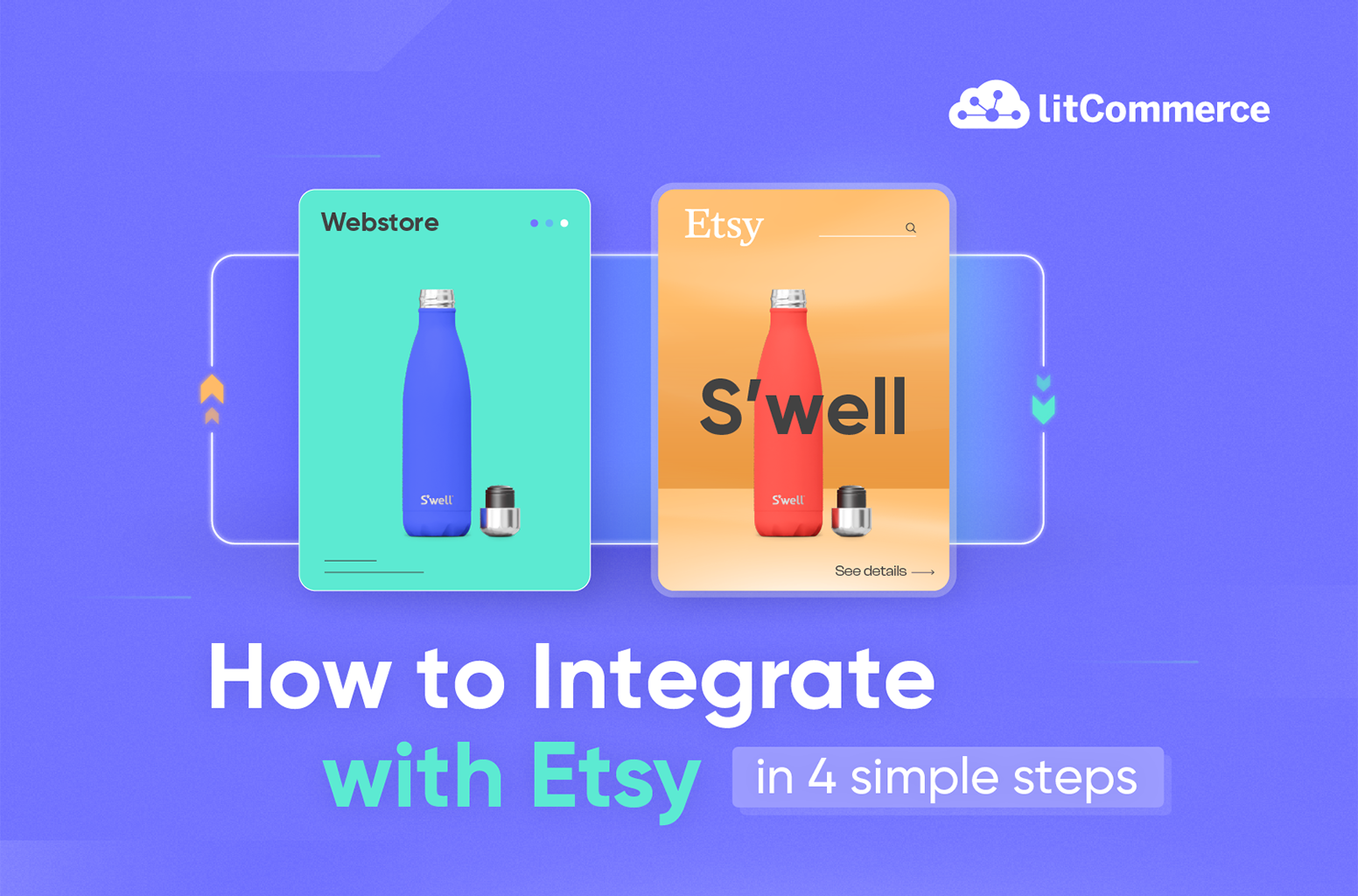So, you are looking for how to integrate with Etsy to boost your business’s sales? Great. You are in the right spot.
Having both your web store and your Etsy shop increases the chances of online shoppers finding your products as you can meet your customers wherever they are, with different behaviors.
Whether you now just have your own web store or sell solely on Etsy, let’s go through this marketplace integration guide to set up your stores:
- Etsy integration overview
- 3 ways of integrating your website with Etsy
- Etsy integration with LitCommerce tool
Ready? Let’s dive in.
How to Integrate with Etsy in 4 Steps
LitCommerce lets you integrate your online store with Etsy and 20+ other sales channels in 4 simple steps. Simplify your multichannel selling and increase your sales today!
What is Etsy Integration? And What to Prepare?
First things first. Etsy integration is the process of integrating your web store into your Etsy store. This integration can help you manage your product listings, inventory, and orders better.
Let’s take an example: You built your website with Shopify. Once your Shopify store is integrated with your Etsy shop, your product listings can be linked. As a result, the stock of that product on both Shopify and Etsy can be synced, helping you to control the stocking level more simply.
Create an Etsy Shop
Etsy is an ideal place to sell one-of-a-kind, handmade, digital, print-on-demand, or drop-shipping products. So if you are selling these kinds of products, integrating your website with Etsy can not only boost your sales but also streamline your selling process across channels.
Before learning how to integrate with Etsy, ensure you have created an Etsy shop to list your products.
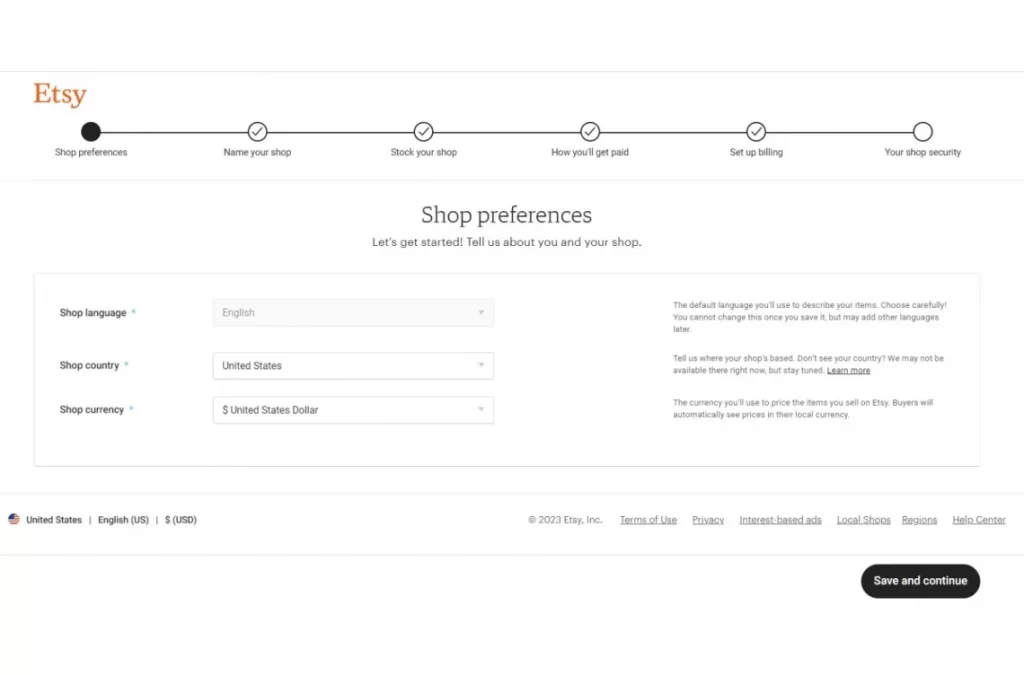
Follow these seven steps below to create your Etsy shop. They are short and easy, we make sure!
- Create an Etsy account: Head to Etsy.com/sell and click Get Started. Then, follow the prompts to finish setting up your Etsy account.
- Select shop preferences and name your shop: Next, you will need to set up your shop with shop language, country, and currency. Then add your shop name. It can only include letters and numbers, no spaces.
- Create product listings: Add product photos, titles, and descriptions and categorize your products. After that, set up the price, stock your inventory, and finally, fill out your shipping options for the listings.
- Connect your bank account: This is how you get paid. Exciting, right? You simply need to enter your personal information, address, and bank account. Make sure it’s compatible with the payment method you use for your eCommerce store to ensure a smooth and efficient financial transaction process.
- Set up billing: This is how you pay to publish your listings and open an Etsy shop. You will be asked to enter a payment method to pay your Etsy bill.
- Secure your shop: In this step, Etsy will require you to add your phone number. This 2-factor authentication is to keep your shop extra safe.
- Go live on Etsy! Once you finish the steps above, your Etsy shop will be ready to launch.
Set up your web store
Alternatively, if you already have an Etsy store and plan to establish your own website, ensure your online store is created before proceeding with Etsy marketplace integration. You don’t necessarily need to upload all your products there at this stage, as we’ll explore in the next section.
When it comes to setting up an eCommerce store, consider popular platforms like Shopify, BigCommerce, WooCommerce (for WordPress), Wix, Squarespace, and Square. These platforms offer diverse features to assist you in swiftly and effortlessly setting up your store, covering aspects such as your product catalog, pricing, payment methods, and more.
How to Integrate with Etsy: 3 Options
Now, you have prepared all the things you need. Let’s dive into how to integrate with Etsy. With the Etsy integration process, you have three main options: manual integration, expert hiring, or using third-party tools. We will walk through each option to find the best fit for your business.
Manual Etsy integration
First, you can manually integrate your website by authorizing your website’s API access to your Etsy account. This method establishes a connection and allows data exchange between the two platforms. However, this can be seen as a quite tricky option as it requires some programming knowledge and experience.
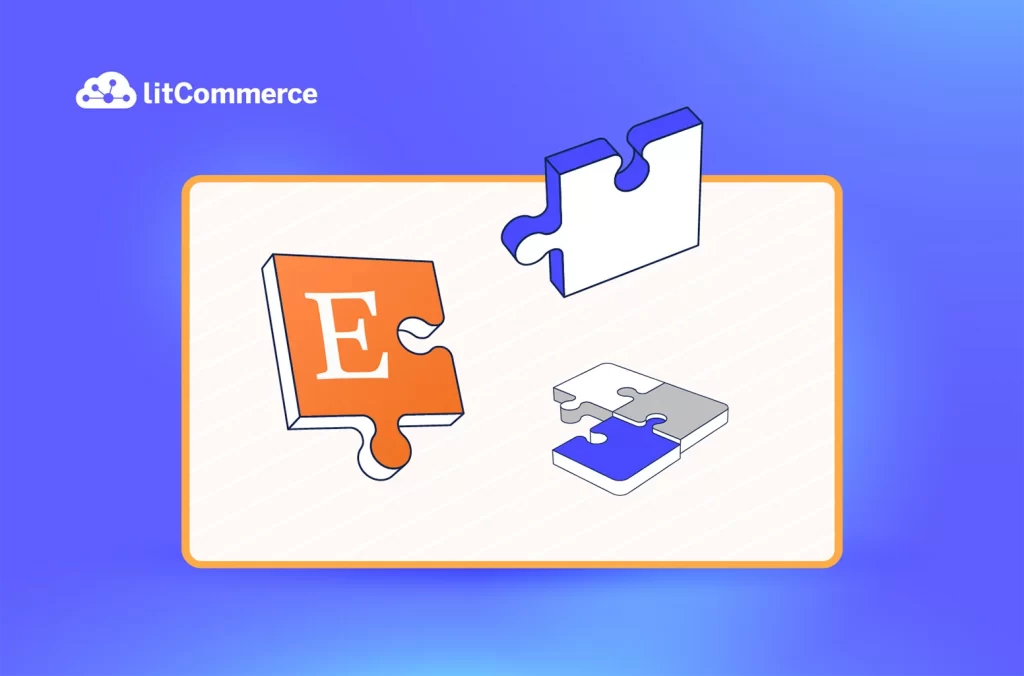
Expert hiring
Otherwise, if you have the budget, you can hire technical experts to set up the Etsy integration for you. The biggest benefit of this Etsy marketplace integration method is that you can order whatever you want, and they will customize it for you. Moreover, they can not only integrate but also set up and optimize your store.
When hiring an Etsy integration expert, look for experts who have a track record of successfully integrating businesses with Etsy and specialize in your industry. You can find qualified experts on freelancing platforms, LinkedIn, and industry-specific forums.
However, hiring someone with coding expertise to do all the data integration costs quite a lot of money. Additionally, given that selling is a long-term journey, unexpected issues may arise, potentially leading to additional fees. If your business is on a tight budget, take the last “how to integrate with Etsy” option into consideration.
Third-party tools
The last and most effective way to integrate with Etsy, as we can see, is to use third-party tools. Most of the eCommerce platforms have integrating apps available that support you in integrating with marketplaces like Etsy.
These multichannel selling tools come with affordable pricing tiers and especially features that were developed to simplify the integration procedures. Some of the most popular apps for Etsy integration are LitCommerce, CedCommerce, Sellbrite, and Codisto.
LitCommerce is a powerful multichannel selling solution for businesses of all sizes and most of the best-selling marketplaces in the world. Our most popular packages for Etsy integration include:
- Shopify Etsy integration
- Wix Etsy integration
- WooCommerce Etsy integration
- BigCommerce Etsy integration
- Squarespace Etsy integration
How to Integrate with Etsy Using LitCommerce App
So now, if you decide to go for using the Etsy integration tool to simplify your setup process, let’s explore how to integrate with Etsy using LitCommerce.
Try Integrating with Etsy using LitCommerce
List products in bulk, sync price, inventory, and orders within clicks using the LitCommerce app. We’ll take the hard work so you can enjoy a seamless multi-selling ride.
Step 1: Set up your web store on LitCommerce
The first step on how to integrate with Etsy using LitCommerce go to the LitCommerce app, create your account, and connect your web store. Your web store will run like a main store or a headquarters for all your stores, where you set inventory sources and manage the orders across different stores.
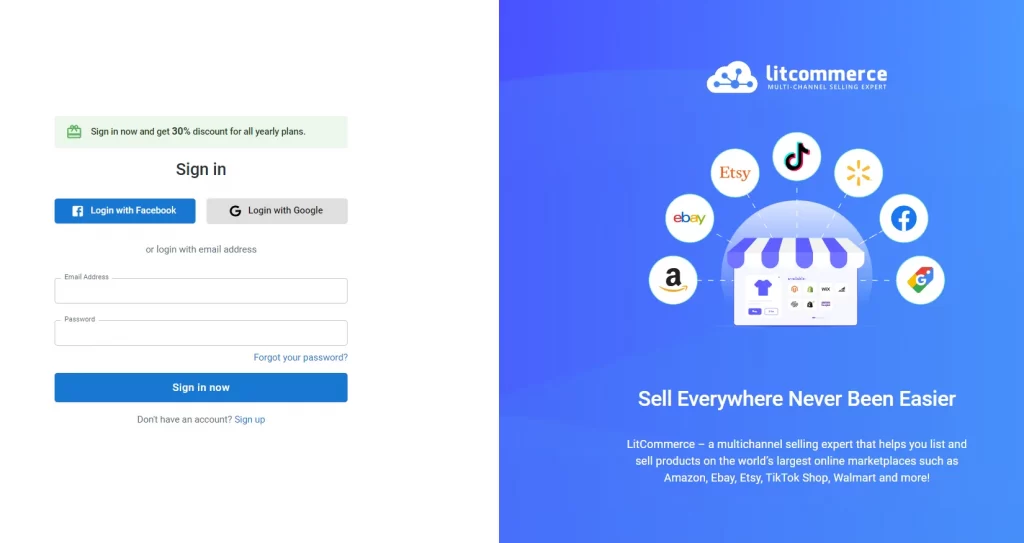
Once you finish the registering step, LitCommerce will head you to the Setup page where you can connect your web store to LitCommerce. Currently, LitCommerce supports connecting to 6 eCommerce platforms, including Shopify, BigCommerce, WooCommerce, Wix, and Squarespace, and Square.
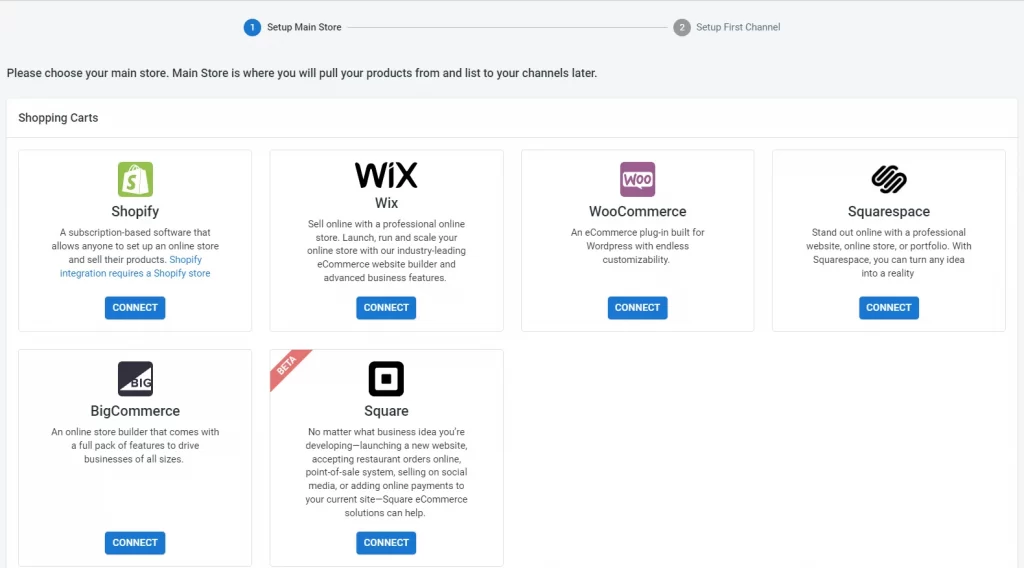
Simply click Connect under the eCommerce platform you are using for your store, and fill in the required information. And that’s it. Simple and easy. You have successfully connected your web store to LitCommerce.
Or else you can also set up the LitCommerce tool directly from your eCommerce platforms. Head to your platform’s application or plugin stores, search for LitCommerce, and follow the prompts.
After you finish setting up your web store, we will automatically import your listing from your store to LitCommerce.
Step 2: Connect your Etsy shop
Moving on to how to integrate with Etsy, LitCommerce will head you to the Setup First Channel page. Here, you can connect your Etsy shop.
To connect your Etsy shop, click the Connect button below the Etsy logo. Give your shop a name, then just follow the instructions, and you are good to go.
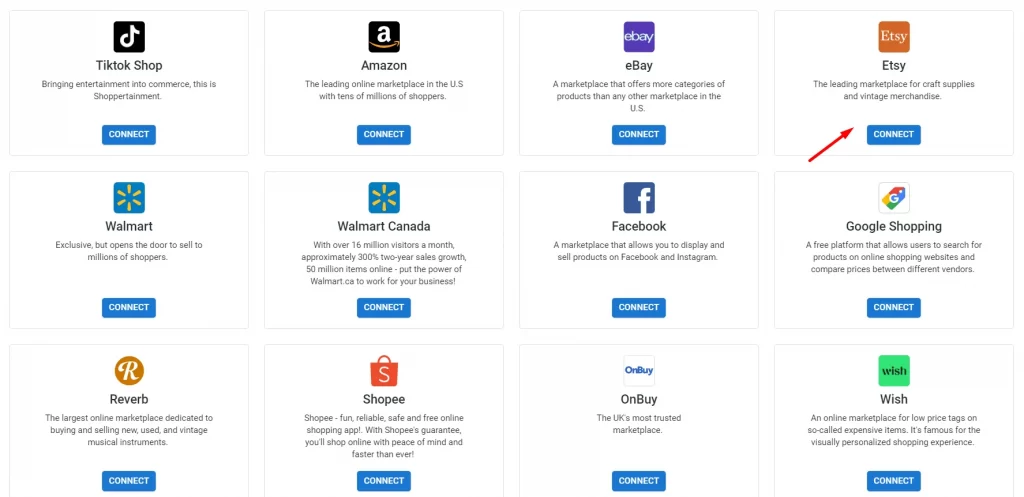
Once your Etsy shop is connected, LitCommrce also lets you integrate with other leading marketplaces, including TikTok Shop, Amazon, eBay, Walmart, Facebook Shops, Google Shopping, Wish, OnBuy, and Reverb. This helps your business grow beyond just your website and Etsy, reaching more customers and boosting your sales.
Step 3: List products on Etsy or link your product listings
Learning how to integrate with Etsy and selling your products there is a great way to increase your sales. Now that you have connected both your website and your Etsy shop. It’s time for the most important part of this Etsy marketplace integration process: List products.
We divide it into 3 use cases to cover all your store status.
- List products from your web store to Etsy
- Import products from Etsy and list them on your web store
- Link the same products on both channels
Use case 1: List products from your web store to Etsy
Follow these steps below to list your products from your current web store to Etsy:
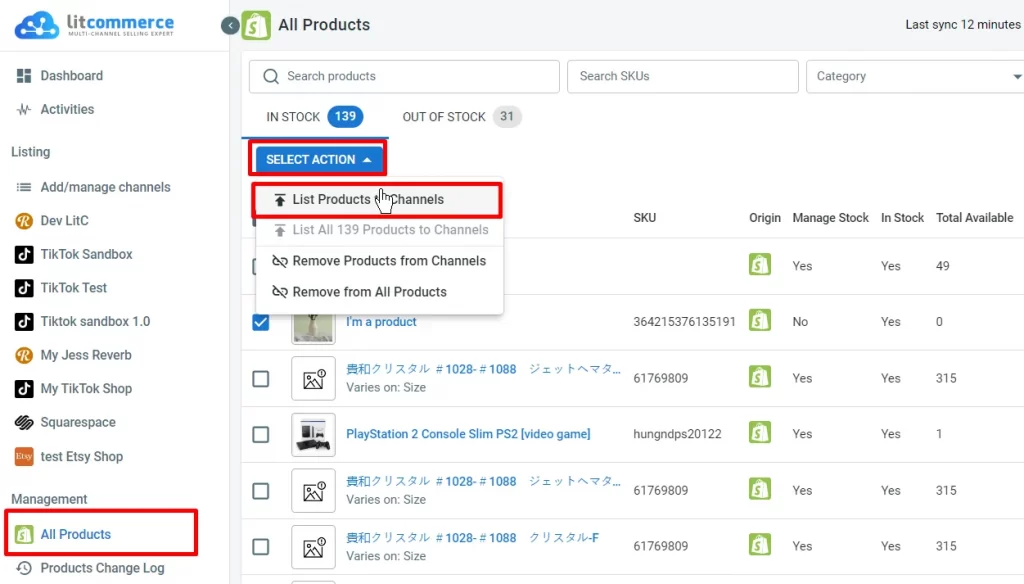
- Navigate to the All Product section in the left sidebar.
- Tick the checkboxes next to the products you want to list on Etsy
- Select Select action and choose List products to channels
- Tick the box beside your Etsy store and Add As Draft Now
Note:
If you list your products on Etsy using LitCommerce for the first time, you will see a pop-up set-up-templates window. This feature assists you in automatically applying the template each time you create new draft listings on Etsy, ensuring consistent inclusion of essential information without overlooking key details that may not be required for their own website, such as Etsy shipping profile and return policy.
Once you finish these steps, your product listings will become the Draft listings on your Etsy shop on LitCommerce. You will need to edit them before publishing them on your Etsy shop.
To publish the draft listings on your Etsy shop, click on Etsy shop on the sidebar. Here you have 2 options: edit your product listing in Single Mode or use the Quick Grid feature (only available for premium plans). With the Quick Grid, you will have a spreadsheet interface to edit your products in bulk.
Moreover, instead of editing each listing individually, the Templates and Recipes feature of LitCommerce might also help you a lot if you have a specific formula for your Etsy listing.
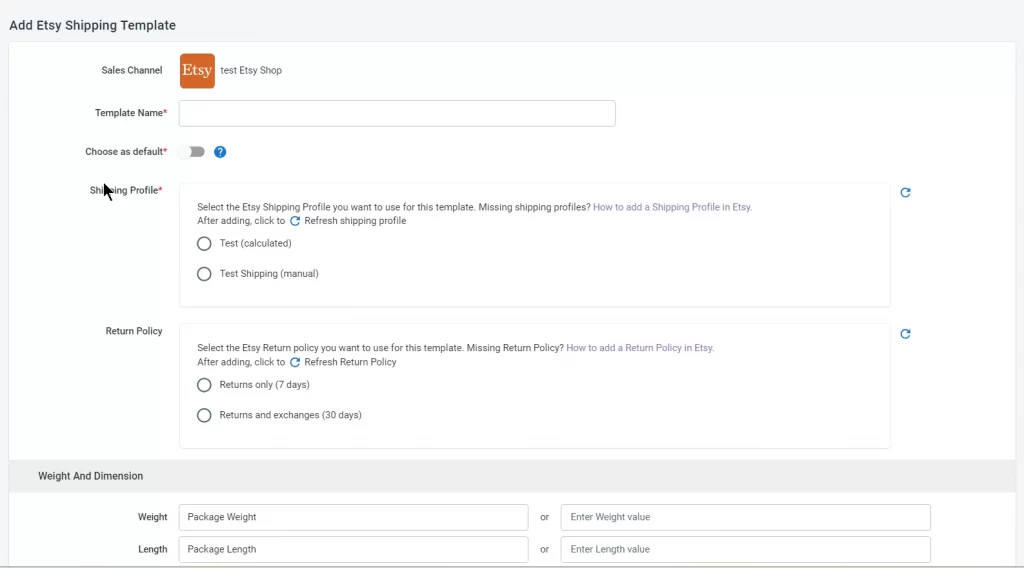
So, if you just want to list your products separately, follow these steps:
- Click on the product listing you want to list on Etsy
- Edit your listing information, including product title, SKU, description, product images, price, category, and shipping information.
- Finally, simply click Save & Publish to Etsy.
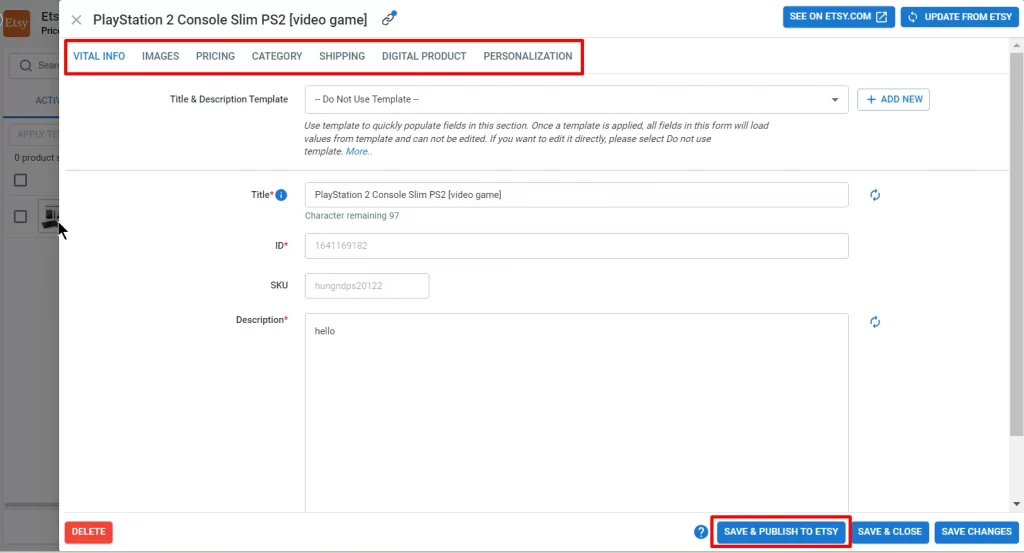
After finishing these steps above, switch to your Etsy draft listings section; you will see the product you just listed there.
Use case 2: Import products from Etsy and list them on your web store
Transforming from Etsy to your own website is a big step. It can be very exciting but also very overwhelming and time-consuming if you have to list hundreds of products there manually. In this case, let us show you how LitCommerce makes it easy by helping you import all Etsy product listings and list them on your website.
Moreover, importing your listings from Etsy to your website also allows you to synchronize your data between 2 channels more properly and manage them more efficiently.
Follow the steps below to import and manage them on your website:
- Go to your Etsy store on LitCommerce and click Import from Etsy.
- Then you will have some options, such as re-importing all deleted products, then choose the ones that fit you.
- After that, click Begin Import, and you will see them on your Etsy store (on LitCommerce).
- Lastly, Select the listings you want to list on your web store and click Create on Shopify (or BigCommerce, WooCommerce, etc., depending on your platform).
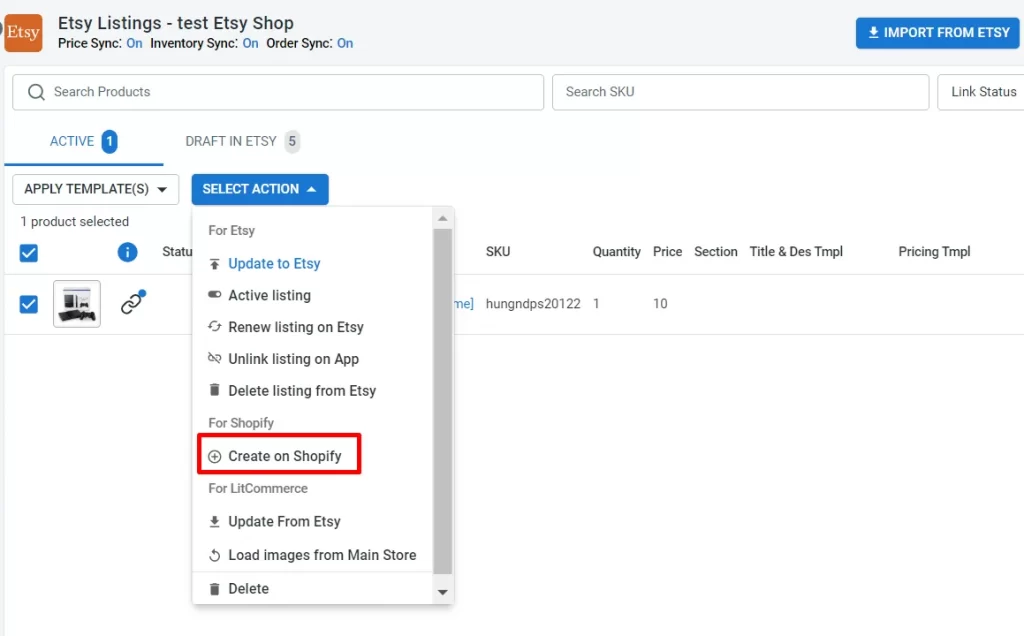
After that, the listings will be instantly created on your web store’s catalog.
Use case 3: Link the same products on both channels
Next, in this how to integrate with Etsy guide, we will go to the case that you have listed products on both your web store and your Etsy shop, and you want to link them together to sync sales and inventory.
For this case, you need to Import from Etsy, like the second case. If you follow the default options of LitCommerce when importing your listings from Etsy, LitCommerce will automatically link the same products on your catalog or the products that have the same SKU.
Otherwise, if the SKU doesn’t match, manually link your listings. Here’s how:
- Hover over the red icon on the unlinked listings, click Link to a product, and LitCommerce will help you find the matching items.
- Otherwise, type the SKU of the item you want to link to.
- Hit Select beside the item showing up on the screen, and you will receive a notification when the linking is done.
Step 4: Sync your inventory and order
In this step on how to integrate with Etsy, let’s uncover how to set up inventory and order synchronization for your store.
Set up inventory sync
To synchronize your inventory across your stores, follow these steps:
- Click on Channel settings in the bottom right corner
- Scroll down to the Inventory section and turn on Inventory Sync.
- Then click Save Settings to save your changes at the page’s bottom.

Moreover, you can also set customized rules for your inventory. Quantity, maximum quantity, and minimum quantity are three statics you can set for your inventory.
- Quantity: Set your Etsy stock to a specific percentage of all your current stock.
- Maximum quantity: Display the maximum amount of items left on Etsy. This is especially useful for creating a sense of scarcity.
- Minimum quantity: Display a minimum quantity, regardless of your central catalog stock.
Sync your order and centralize your order fulfillment
The last step in this Etsy marketplace integration is to sync and manage your orders. LitCommerce centralizes your order fulfillment process by pulling your orders from your Etsy shop to your web store.
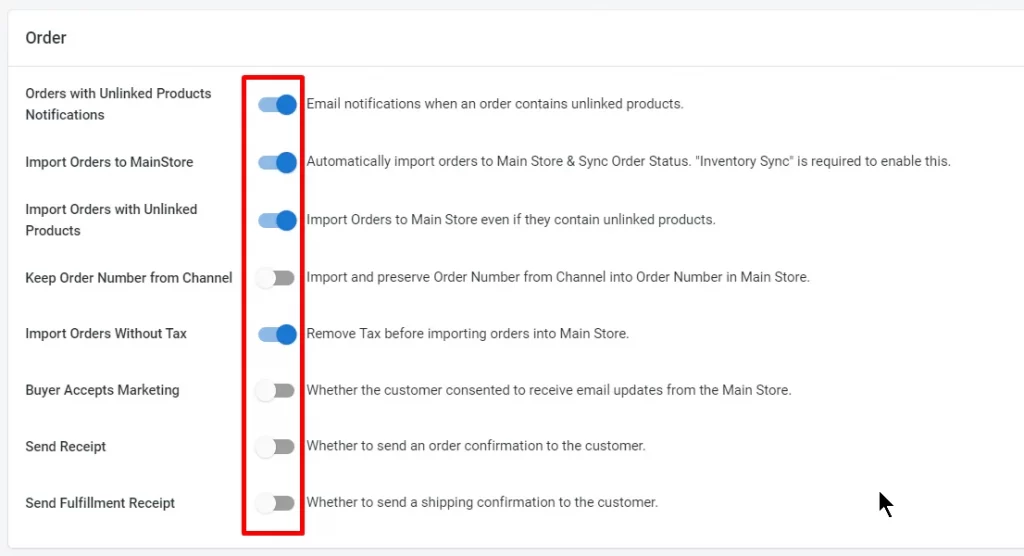
Let’s take the example of Etsy integration with Shopify. When your customer places an order on Etsy, you can also see it on your Shopify store and fulfill it directly there without the hassle of switching among various channels.
Here is how to sync your orders across channels:
- Click on Channel Settings down to the bottom of the sidebar
- Turn on Import Orders to Mainstore.
Why Choose LitCommerce for Etsy Integration
That’s all bout how to integrate with Etsy using the LitCommerce app. Let’s have an overview look at how LitCommerce can help you run your business easier, faster and smarter.
LitCommere’s main features
Here are the main features we expect to help you sell across channels effortlessly:
- Multichannel Listing: By integrating all your stores, LitCommerce brings multiple channels into one single place, saving you the time and effort of multichannel management.
- Bulk listing: As one of our customers once said, “Listing takes so much time away from creating”, LitCommerce was founded mainly to solve this problem. You can upload all your products to the best-selling marketplaces in a few clicks. Moreover, you can edit products in filtered groups using a spreadsheet layout – QuickGrid, making the listing process even faster.
- Real-time inventory sync: Say goodbye to manual updates. Our Live Sync feature ensures that inventory is automatically updated in real-time whenever your customer places an order. With this feature, your business can avoid stocking out or inaccurate inventory data.
- Integrated order flow: This centralized approach of Etsy integration allows you to import your orders from Etsy directly into your website, which will help you efficiently manage and process orders.
Check out the LitCommerce pricing, or contact us if you have any questions.
Customer reviews
After nearly 2 years of release, we are proud to help thousands of sellers run their business easier. It’s truly rewarding and motivating for us to get 4.9/ 5 stars on Trustpilot, with 99% of reviews being 5 stars.
This is the feedback from Creative Designs by Della:
I was struggling to understand how to use some of the features to link my Etsy shops with my Wix website. Ember at the help chat was so knowledgeable and helpful. She was very patient and saved me so much time. I was ready to give up, but I’m continuing my subscription. I had subscribed to save time, and the help chat was what convinced me. Listing takes so much time away from creating, and this is worth every penny, especially when the chat is so helpful!!
We also got this feedback from V12 RS from Canada on Shopify:
They have exceptional customer service! They respond extremely fast on their chat!
The app itself saves us so much time to upload products on eBay, Etsy, Amazon, and Walmart! It is quite an advanced app, so you do need to spend time to learn it, but once you know how to use it, it’s amazing!
Etsy Integration – FAQs
Etsy integration is the process of connecting your online store to the Etsy marketplace. It enables you to seamlessly sell your products on Etsy, reach a broader audience, and benefit from the brand’s extensive resources and fulfillment network. Etsy sync also allows you to centralize your selling process, manage orders and inventory, and streamline your fulfillment operations. You can integrate Etsy with various platforms, such as Shopify, BigCommerce, WooCommerce, Wix, Squarespace, and Square. To integrate with Etsy, you can hire an expert. Otherwise, use integration tools like LitCommerce, which can let you list products in bulk, synchronize your inventory, and centralize your order fulfillment. Yes, of course. You can use integration tools such as LitCommerce to integrate your Etsy shop into your website. LitCommerce lets you synchronize your listings, inventory, and orders, helping you easily manage all of your stores in one single place.
Integrate with Etsy and Increase Your Sales Today
Clearly, having both your website and Etsy shop allows you to tap into both two markets and reach different kinds of customers.
Integrating with Etsy might come with challenges, but the benefits related to listing, inventory sync, and order management centralization are really worth it. Follow the steps outlined in this how to integrate with Etsy using the LitCommerce guide. You can seamlessly integrate your web store with Etsy and take your business operations to the next level.
Happy selling!

